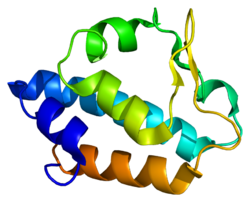Biology:Peptide-N4-(N-acetyl-beta-glucosaminyl)asparagine amidase
| peptide-N4-(N-acetyl-beta-glucosaminyl)asparagine amidase | |||||||||
|---|---|---|---|---|---|---|---|---|---|
 | |||||||||
| Identifiers | |||||||||
| EC number | 3.5.1.52 | ||||||||
| CAS number | 83534-39-8 | ||||||||
| Databases | |||||||||
| IntEnz | IntEnz view | ||||||||
| BRENDA | BRENDA entry | ||||||||
| ExPASy | NiceZyme view | ||||||||
| KEGG | KEGG entry | ||||||||
| MetaCyc | metabolic pathway | ||||||||
| PRIAM | profile | ||||||||
| PDB structures | RCSB PDB PDBe PDBsum | ||||||||
| Gene Ontology | AmiGO / QuickGO | ||||||||
| |||||||||
In enzymology, a peptide-N4-(N-acetyl-beta-glucosaminyl)asparagine amidase (EC 3.5.1.52) is an enzyme that catalyzes a chemical reaction that cleaves a N4-(acetyl-beta-D-glucosaminyl)asparagine residue in which the glucosamine residue may be further glycosylated, to yield a (substituted) N-acetyl-beta-D-glucosaminylamine and a peptide containing an aspartate residue. This enzyme belongs to the family of hydrolases, specifically those acting on carbon-nitrogen bonds other than peptide bonds in linear amides.
The NGLY1 gene encodes the ortholog of this enzyme in humans.
Nomenclature
The systematic name of this enzyme class is N-linked-glycopeptide-(N-acetyl-beta-D-glucosaminyl)-L-asparagine amidohydrolase. Other names in common use include:
- glycopeptide N-glycosidase,
- glycopeptidase,
- N-oligosaccharide glycopeptidase,
- N-glycanase,
- Jack-bean glycopeptidase,
- PNGase A,[1] and
- PNGase F
Structural studies
The enzyme uses a catalytic triad of cysteine-histidine-aspartate in its active site for hydrolysis by covalent catalysis.[2] A peptide with similar functionality was discovered in 2014 by group at Fudan University in Shanghai, China. This peptide also cleaves alpha 1,3 linkages, and has been named PNGase F-II.[3]
References
- ↑ "Characterisation of peptide-N4-(N-acetyl-beta-glucosaminyl)asparagine amidase A and its N-glycans". European Journal of Biochemistry 252 (1): 118–23. Feb 1998. doi:10.1046/j.1432-1327.1998.2520118.x. PMID 9523720.
- ↑ "The PUB domain functions as a p97 binding module in human peptide N-glycanase". The Journal of Biological Chemistry 281 (35): 25502–8. Sep 2006. doi:10.1074/jbc.M601173200. PMID 16807242. http://www.jbc.org/content/281/35/25502.
- ↑ "Identification and characterization of a novel prokaryotic peptide: N-glycosidase from Elizabethkingia meningoseptica". The Journal of Biological Chemistry 290 (12): 7452–62. Mar 2015. doi:10.1074/jbc.M114.605493. PMID 25614628. PMC 4367255. http://www.jbc.org/content/290/12/7452.
Further reading
- "Facile cleavage of complex oligosaccharides from glycopeptides by almond emulsin peptide: N-glycosidase". The Journal of Biological Chemistry 256 (20): 10243–6. Oct 1981. doi:10.1016/S0021-9258(19)68610-2. PMID 7287707.
- "Demonstration of a new amidase acting on glycopeptides". Biochemical and Biophysical Research Communications 76 (4): 1194–201. Jun 1977. doi:10.1016/0006-291X(77)90982-2. PMID 901470.
- "Some characteristics of a new glycopeptidase acting on aspartylglycosylamine linkages". Journal of Biochemistry 84 (6): 1467–73. Dec 1978. doi:10.1093/oxfordjournals.jbchem.a132270. PMID 738997.
- "Deglycosylation of asparagine-linked glycans by peptide:N-glycosidase F". Biochemistry 24 (17): 4665–71. Aug 1985. doi:10.1021/bi00338a028. PMID 4063349.
 |

